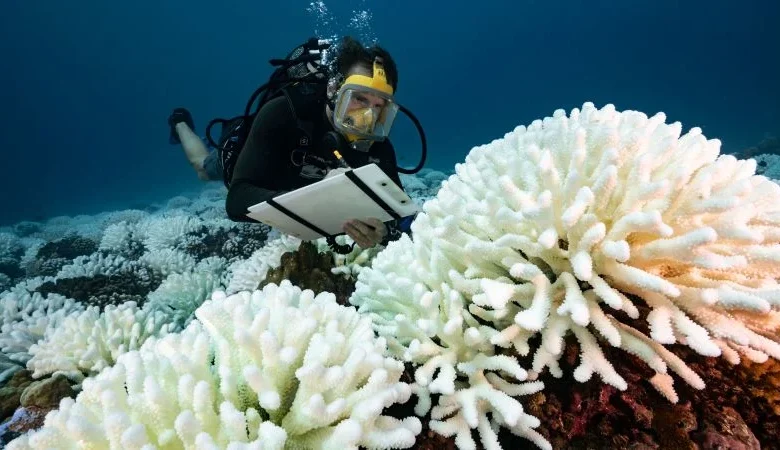New reports paint picture of an unlivable future with warming now expected to blow past key limit

Megacities flooded by surging seas. Mountains bare of the glaciers that once perched on their craggy peaks. Ice sheets crumbling into the ocean. The seafloor carpeted in ghostly skeletons of dead coral reefs.
This isn’t the plot of a disaster movie; it is a realistic picture of the world we are heading toward as global warming ticks upward and the global appetite to tackle the climate crisis wanes, scientists are warning.
A series of reports over the past month have sketched a plausible portrait of our future, and the picture is grim.
Three decades of global climate action have slowed the rise of planet-warming pollution, but it is far from enough. The world is on track for catastrophic warming and, in an alarming twist, the worst impacts of the climate crisis are unfolding decades earlier than scientists predicted.
Countries agreed in Paris in 2015 to make every effort to limit global warming to 1.5 degrees Celsius above pre-industrial levels. But their plans to reduce climate pollution to achieve that goal and prevent the most catastrophic impacts of climate change fall woefully short, according to the recent flurry of reports.
On Wednesday, the International Energy Agency concluded that the 1.5-degree pledge has now “slipped out of reach,” as an energy-thirsty world continues to rely on fossil fuels. The United Nations reached the same conclusion in its annual “Emissions Gap” report published last week, which found the world was on course for 2.3 to 2.5 degrees of warming over this century if governments follow through on their latest pledges. If not, we’re looking at reaching around 2.8 degrees, with a 20% chance of breaching 3 degrees.
On one reading, this is a success; in 2015, when the Paris agreement was signed, the world was on track for 4 degrees of warming.
“I certainly think some self-congratulation is in order — we have replaced enough fossil fuels with clean energy to dramatically reduce climate risks in a single lifetime,” said Kim Cobb, a climate scientist and director of the Institute at Brown University for Environment and Society.
But humanity is careening toward an untenable future.
Three degrees of warming would make our current world, already grappling with sea level rise, water shortages and deadly extreme weather, “look rosy by comparison,” Cobb told CNN.
So far, the world has warmed by about 1.4 degrees Celsius, or roughly 2.5 degrees Fahrenheit. And already, we have seen unprecedented extreme weather events, including the Pacific Northwest heat wave of 2021 that killed hundreds in the US and Canada.
Warming above 2 degrees Celsius could trigger catastrophic and potentially irreversible tipping points in the climate system, such as the collapse of large portions of the ice sheets leading to devastating sea level rise that would swallow cities.
Daniel Swain, a climate scientist at the University of California Agriculture and Natural Resources, categorized a 2- to 3-degree-warmer world as a “catastrophe.”
“A 3-degree-warmer world — just to give a few specific tangible pictures of what that looks like — that’s a world where the sea level is feet higher than it currently is today, where global megacities that are within a few feet of sea level, their viability is seriously threatened,” Swain said on a media call last week.
“This is a world where we see widespread, frequent occurrence of historically unprecedented flood and drought events. It’s a world where we lose almost all of the mountain glaciers, and we start to see massive destabilization of the Greenland and West Antarctic ice sheets. And that’s just a short list,” Swain said.
Joeri Rogelj, director of research at the Grantham Institute at Imperial College London, has worked on each UN Emissions Gap report since the first iteration in 2010. He told CNN that projections of future warming have come down over time, as countries have taken steps to rein in their carbon emissions, pledged to act further, and as newer scientific research has made the higher warming scenarios look somewhat less likely.
“We roughly cut 1 degree of global warming from our expectations… That is good news,” Rogelj said. But, he added, “this year is the first year where — when we’re looking at all the options that we have available for reducing emissions — we don’t find any technically possible pathways anymore that would be limiting warming to 1.5 degrees Celsius.”
Rogelj is not optimistic about the consequences of the 2-degree to 3-degree temperature rise the world is now facing. It is still “extremely dangerous,” he said, for every country but especially for developing countries which endure the worst aspects of the climate crisis and have the fewest resources to adapt.
He pointed to extreme weather and climate events already happening that nations are not yet adapted to. These affect both the Global North and South, from deadly wildfires in the US, Canada and Europe, to devastating heat waves in Pakistan and deadly floods in Vietnam.
“Given the evidence that we see, I would really not consider anything between 2 and 3 degrees livable” he said.
“The more we learn, the worse it looks,” he added. Or to put it another way: “We expect higher risks at lower levels of warming” than previously thought.
Some researchers told CNN that even higher warming scenarios can’t be ruled out yet, despite successive UN reports and others showing a narrowing of the most likely warming range. This is because the climate system is endlessly complex.
“It’s quite possible that carbon cycle feedbacks could result in more warming than expected,” said climate scientist Kate Marvel. She mentioned plausible scenarios involving the large-scale drying and burning of the Amazon rainforest, melting permafrost in the Arctic that can release large quantities of planet-warming pollution, and other mechanisms that could accelerate warming.
“Even 2 to 3 degrees Celsius is scary,” she told CNN.
The warming we have seen to date is already causing “severe” climate disruptions, Marvel said. “We know impacts don’t simply scale up with the temperature — they can be very drastic,” she said. “Sea level rise is no big deal until it overcomes your flood defenses. Drought is manageable until your city or farm runs out of water.”
“I’m glad we’ve made progress, but we can’t sit back, congratulate ourselves, and think we’ll be safe.”




